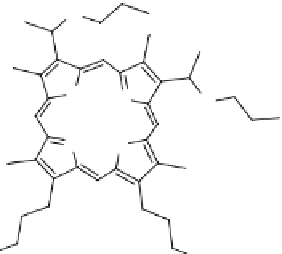Biomedical Engineering Reference
In-Depth Information
Fig. 15
Purpurin-18
(Reproduced by permission
of The Royal Society of
Chemistry)
HO
2
C
H
N
HN
H
O
O
N
NH
O
Fig. 16
2,7,12,18-
Tetramethyl-3,
8-di(1-propoxyethyl)-13,
17-bis-(3-hydroxypropyl)
porphyrin (PHPP)
(Reproduced by permission
of The Royal Society of
Chemistry)
O
NH
N
O
N
HN
HO
OH
Silica covered Fe
3
O
4
magnetic nanoparticles including 2,7,12,18-tetramethyl-
3,8-di(1-propoxyethyl)-13,17-bis-(3-hydroxypropyl)porphyrin (PHPP, Fig.
16
) as
PS were described by Chen, Zhou and co-workers (Chen et al.
2009
). Fe
3
O
4
nano-
particles were prepared by co-precipitation and were about 10 ± 2 nm in diameter.
AOT/1-butanol/water micelles method was combined with sol-gel method in pres-
ence of PHPP to coat the magnetic particles with silica. The resulting particles were
about 20-30 nm in diameter but some agglomeration could be observed, as shown
by TEM images. The encapsulation of the PS was checked by FT-IR measurements
and photoluminescence of PHPP. The efficiency of PHPP encapsulation was esti-
mated by UV-visible spectroscopy after destruction of Fe
3
O
4
cores of the nanopar-
ticles and was found to be around 21%. The RNO-bleaching method allowed to
evaluate a significant
1
O
2
generation.
In vivo
photodynamic efficacy was evaluated
on SW480 colon carcinoma cells. No significant dark toxicity was detected for all
tested concentrations until 80 mmol/L. PDT experiments were performed on the
same cell lines and significant PDT efficacy (40% cell viability lost) was found
(24 h incubation time, 10 min, 488 nm laser irradiation, 4.35 J/cm
2
). The potential
of the magnetic core for imaging and therapy is yet to be tested.
Zinc(II) phthalocyanines (ZnPc, Fig.
17
) are second generation photosensitizers
useful for PDT applications. However, the low solubility of these compounds result
in the formation of aggregates in aqueous media, and thus in a loss of efficiency.
Kim et al. (
2009a
) included ZnPc into Fe
3
O
4
-loaded mesoporous silica nanoparti-
cles (MSN). MSN have been used for various biomedical applications such as cell





Search WWH ::

Custom Search